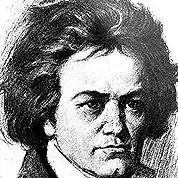Moonlight Sonata III Presto Agitato by Ludwig van Beethoven (1770-1827)
 Ludwig van Beethoven was a German composer and pianist. The crucial figure in the transition between the Classical and Romantic eras in Western art music, he remains one of the most famous and influential composers of all time. |



Notes
The Piano Sonata No. 14 in C♯ minor “Quasi una fantasia”, Op. 27, No. 2, by Ludwig van Beethoven, popularly known as the Moonlight Sonata (Mondscheinsonate in German), was completed in 1801. It was dedicated in 1802 to his pupil, the then 20-year-old Countess Julie Guicciardi, with whom Beethoven was, or had been, in love. It is one of Beethoven’s most popular piano sonatas, as well as one of his most famous compositions for the piano. The name “Moonlight” Sonata derives from an 1832 description of the first movement by music critic Ludwig Rellstab, who compared it to real moonlight shining upon Lake Lucerne.
Romantic Era. 204 Measures. 19 Pages. Time Signature 4/4. key of a minor.
The stormy final movement (C♯ minor), in sonata form, is the weightiest of the three, reflecting an experiment of Beethoven’s (also carried out in the companion sonata, Opus 27, No. 1 and later on in Opus 101) placement of the most important movement of the sonata last. The writing has many fast arpeggios and strongly accented notes, and an effective performance demands lively and skillful playing.Its combination of difficult chromaticism and prestissimo ascending arpeggios make it one of the most difficult and virtuosic compositions for the solo piano, demanding supreme technical skill to play accurately according to Beethoven’s own metronome marking. It is thought that the C-sharp minor sonata, particularly the third movement, was the inspiration for Frédéric Chopin’s Fantaisie-Impromptu, which manifests the key relationships of the sonata’s three movements. Of the final movement, Charles Rosen has written “it is the most unbridled in its representation of emotion. Even today, two hundred years later, its ferocity is astonishing. Beethoven’s heavy use of sforzando notes, together with just a few strategically located fortissimo passages, creates the sense of a very powerful sound in spite of the predominance of piano markings throughout. Within this turbulent sonata-allegro, there are two main themes, with a variety of variation techniques utilized.
